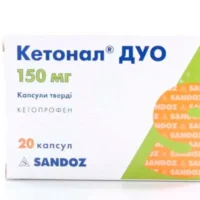Description
Arcoxia (Etoricoxib) Coated Tablets 60 mg. №7
Ingredients:
Each coated tablet contains 60 mg of etoricoxib as the active ingredient.
Mechanism of Action:
Etoricoxib, a selective COX-2 inhibitor, exerts its anti-inflammatory and analgesic effects by inhibiting prostaglandin synthesis.
Pharmacological Properties:
Arcoxia tablets contain etoricoxib, which acts as an anti-inflammatory and analgesic agent by targeting the COX-2 enzyme.
Indications for Use:
Arcoxia tablets are indicated for the relief of acute pain, chronic musculoskeletal pain, osteoarthritis, and rheumatoid arthritis.
Contraindications:
Do not take Arcoxia if you have a history of allergic reactions to etoricoxib or other NSAIDs. It is contraindicated in patients with active peptic ulcers or gastrointestinal bleeding.
Side Effects:
Common side effects of Arcoxia may include gastrointestinal disturbances, headache, and dizziness. Serious side effects may include cardiovascular events and skin reactions.
Usage Instructions:
The recommended dosage is one 60 mg tablet per day. Swallow the tablet whole with a glass of water. It can be taken with or without food.
Benefits Compared to Analogues:
Arcoxia has shown superior pain relief and improved physical function compared to placebo in patients with osteoarthritis. It is also effective in reducing pain intensity in individuals with rheumatoid arthritis.
Suitable Patient Groups:
Arcoxia is suitable for adult patients with acute or chronic musculoskeletal pain, osteoarthritis, or rheumatoid arthritis. It is not recommended for children, pregnant women, breastfeeding mothers, or patients with a history of cardiovascular disease.
Storage Conditions and Shelf Life:
- Arcoxia tablets should be stored in a cool, dry place away from direct sunlight.
- Do not use Arcoxia after the expiration date printed on the packaging.
Packaging Description:
Arcoxia is available in blister packs containing 7 coated tablets of 60 mg strength.
Clinical Evidence and Proven Effectiveness:
Clinical studies have shown that etoricoxib is effective in managing pain and inflammation associated with musculoskeletal conditions. Research published in the Journal of Rheumatology and the European Journal of Pain demonstrated the efficacy of etoricoxib in osteoarthritis and rheumatoid arthritis patients, respectively.





